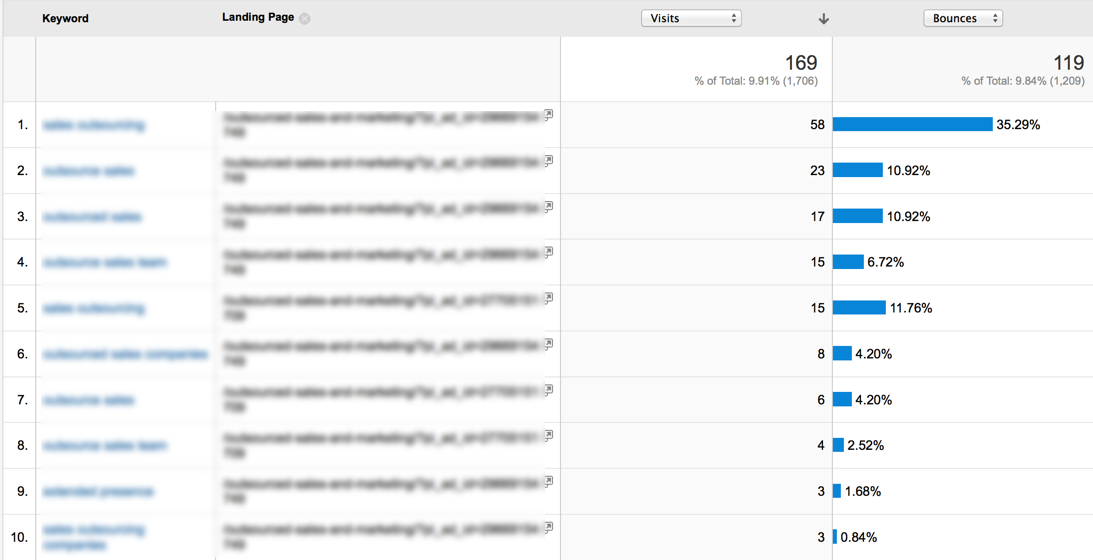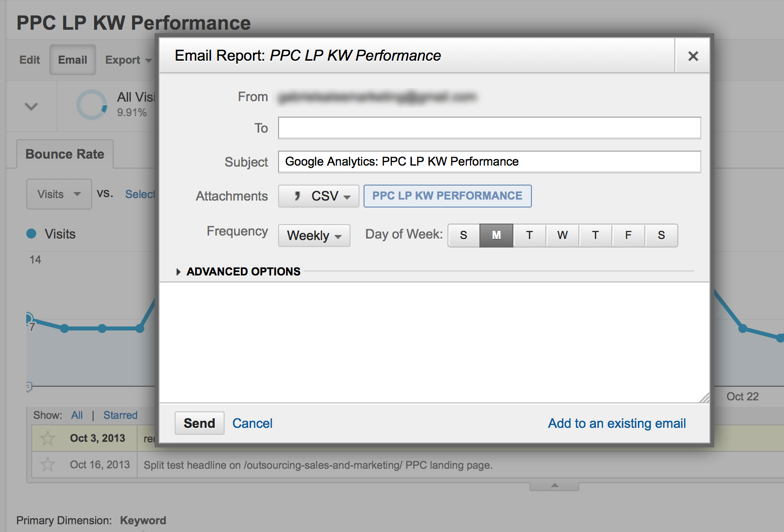by gabriel_sales | Nov 7, 2013
Bounce rate (if you are unfamiliar) is the percentage of visitors who leave a site without visiting any additional pages. Besides goal conversion rates, improving bounce rates is an excellent starting measurement point for indicating improved landing pages.
For landing page optimization, the bounce rate is a gauge of how relevant, interesting or educational your content is related to the referring source. Look at your top landing pages by referring source and to see where you are providing a good inbound experience and conversely where you need to create a better experience.

As an example analysis, below we see that our bounce rate is higher than we’d like on our AdWords campaign:

So we drilldown into the keywords to see which ones are performing least effectively (Hint: build a custom Google Analytics report):
By finding this information, we might decide to:
1) Move the poor performing keywords to a different Ad Group and create a new ad/landing page that is more directly related to the keywords we’ve moved.
2) Improve messaging to make the benefits more clear and share quantitative claims to better communication our offer.
3) Add a stronger and simpler call to action (e.g. reduce form field requirements) that supports getting our visitors to engage.
4) Split test headlines, images, call to action phrases and layouts.
Utilize the annotation feature of your web analytics platform so you know the start and end points for comparing performance and see results:

Lastly, to further take advantage of your web analytics tool, schedule a report (daily/weekly/monthly) to be emailed to you so you don’t forget to do the follow-up analysis on improvement or degradation.

As you can see working on bounce rate reduction can be a serious undertaking, especially if you are focusing on a page-by-page basis. Start with your most heavily visited landing pages to have the highest impact in the most efficient manner. Hopefully the steps above make your bounce rate improvement project more manageable.
This article is part of a new series in which we feature specific ways to use inbound marketing analytics for improving your marketing performance.
by gabriel_sales | Nov 5, 2013

This is part-two of a two-part blog describing the difference between inbound marketing vs. outbound marketing for B2B. Click here for part one.
Inbound marketing refers to instances when your prospect finds and reaches out to you on their own. In the B2B space, there are three main strategies to help make this happen:
1. Content marketing
Content marketing involves publishing digital marketing content in the form of blog posts, white papers, YouTube videos, etc. and then getting that content in front of your prospects by pushing the content. By creating content for each stage of your buyer’s buying cycle—from discovery to consideration of alternatives, etc.—you help guide your prospects to the close.
2. SEO
SEO simply refers to getting to the top of Google’s (and other search engine) results pages. Buyers today have access to a wealth of commercial information, and 89% of buyers use search engines to research their purchase decisions (www.firepolemarketing.com). As a marketing tactic, SEO means creating and optimizing both your website and your marketing content so your prospects can easily find it when they use search engines like Google. To learn more about SEO, click here.
3. Social media
Social media platforms are a new and effective way to increase exposure and generate new leads. As most of your prospects are already on social media, this is great way to encourage participation and interaction. By regularly publishing blog articles and posting updates in the various social media platforms (Facebook, Twitter, Linkedin, etc.), your name stays in front of your prospects and they can easily engage with you anytime they have the need.
Depending on your product/service, industry and length of buying cycle, a different mix of inbound and outbound techniques may be appropriate. While many outbound techniques are waning in effectiveness, for many in the B2B industry, they are still essential. Inbound tactics have recently seen a huge spike in effectiveness; Hubspot recently found that social media has a 100% higher lead-to-close rate than outbound marketing. However, each company is different and it often takes a lot of research and testing to find the most efficient and effective blend.
To learn more about the sales and marketing trends you will need to thrive in 2014, click here. If you have any questions, please feel free to contact us.
by gabriel_sales | Nov 4, 2013
 For B2B companies, the world of marketing is becoming increasingly complex. Traditional marketing functions like branding and positioning are falling to the wayside and CRM and marketing automation are taking their place.
For B2B companies, the world of marketing is becoming increasingly complex. Traditional marketing functions like branding and positioning are falling to the wayside and CRM and marketing automation are taking their place.
To help get your head around the different strategies for marketing in the B2B space, here is a basic overview of the difference between inbound and outbound marketing.
Outbound Marketing
B2B outbound marketing refers to marketing efforts directed from inside the company to prospects that may or may not be expecting to be contacted. For B2B companies today, there are three main strategies for outbound marketing:
1. Cold calling
Perhaps the most traditional of B2B marketing tactics, cold calling is still frequently used today. It is still the most effective way to pinpoint and target people; however, people pick up the phone much less than they used to—making this tactic half as efficient as it was four years ago.
2. Email campaigns
Email marketing campaigns are great way to introduce your company to prospects and keep your name top of mind over time. Most business people now check their email inboxes multiple times a day, so this is perhaps the best outbound tactic for finding new leads. The most effective email marketing campaigns focus on how your product/service can solve a particular problem.
3. Referrals
One of the best ways to get an executive to listen to you is to tell them you have been referred by someone they know. This creates an immediate connection and gives your prospect a reason to give you their full attention. While referrals are more rare, they tend to have higher conversion ratios.
To continue reading, click here.






